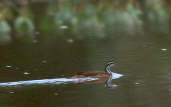
September 2000
The Sungrebe is related to the Finfoots of Africa and South-East Asia. It acts much like a grebe which it replaces in forest streams and rivers with overhanging vegetation in tropical Central and South America.
They are very shy and it is unusual to get a good look at them. This is invariably while they are on the water "usually seen swimming away" since, while they spend a lot of time in surrounding vegetation, they are very difficult to see there.
The Sungrebe is unique in the fact that the male has a pouch under each wing in which a chick can be hidden and, indeed, transported both while swimming and while flying. This was first observed by a German explorer, Prince Maximilian of Weid in 1816 but seemed so unlikely that it was disregarded until the same behaviour was observed some 150 years later in Mexico by Alvarez del Toro.
| Previous Page | Back to Index | Next Page |